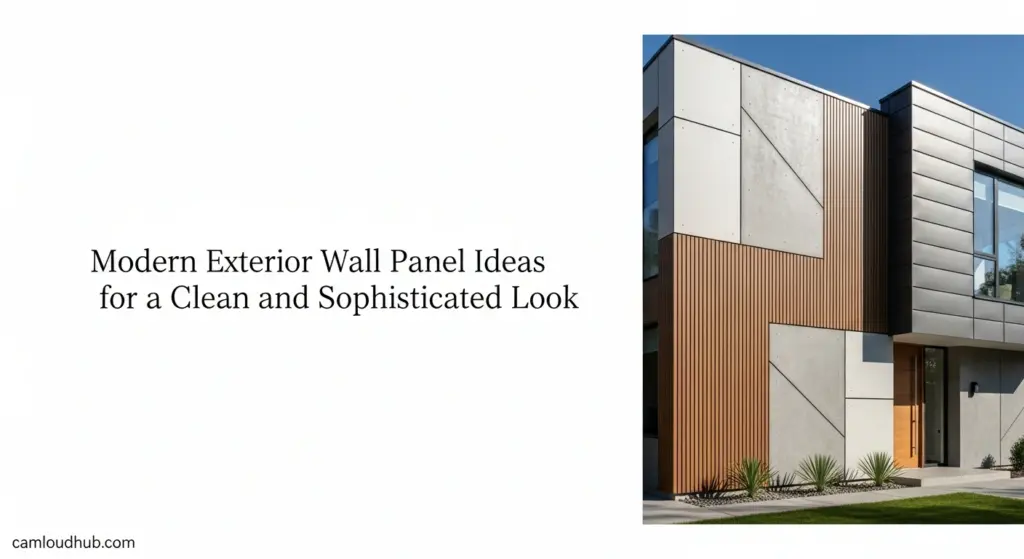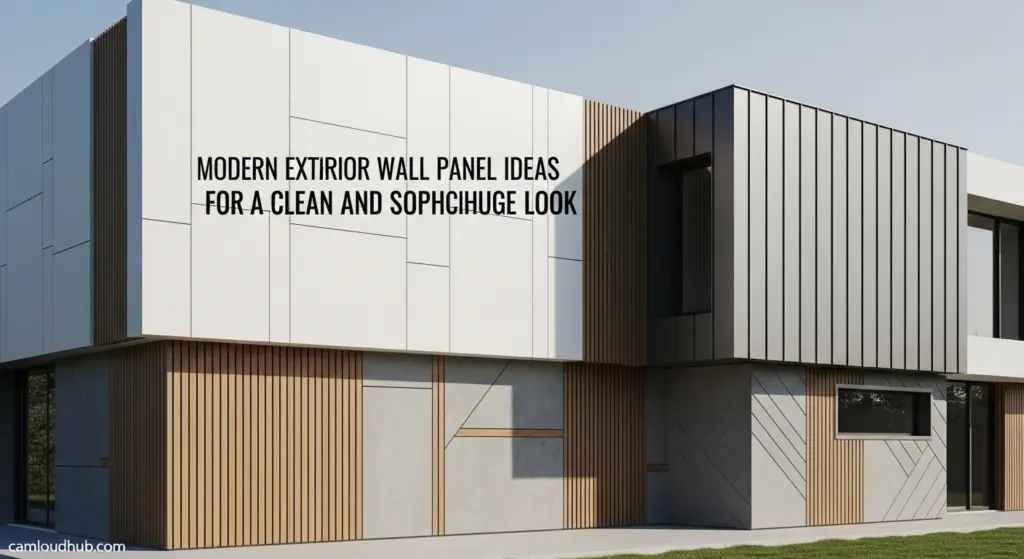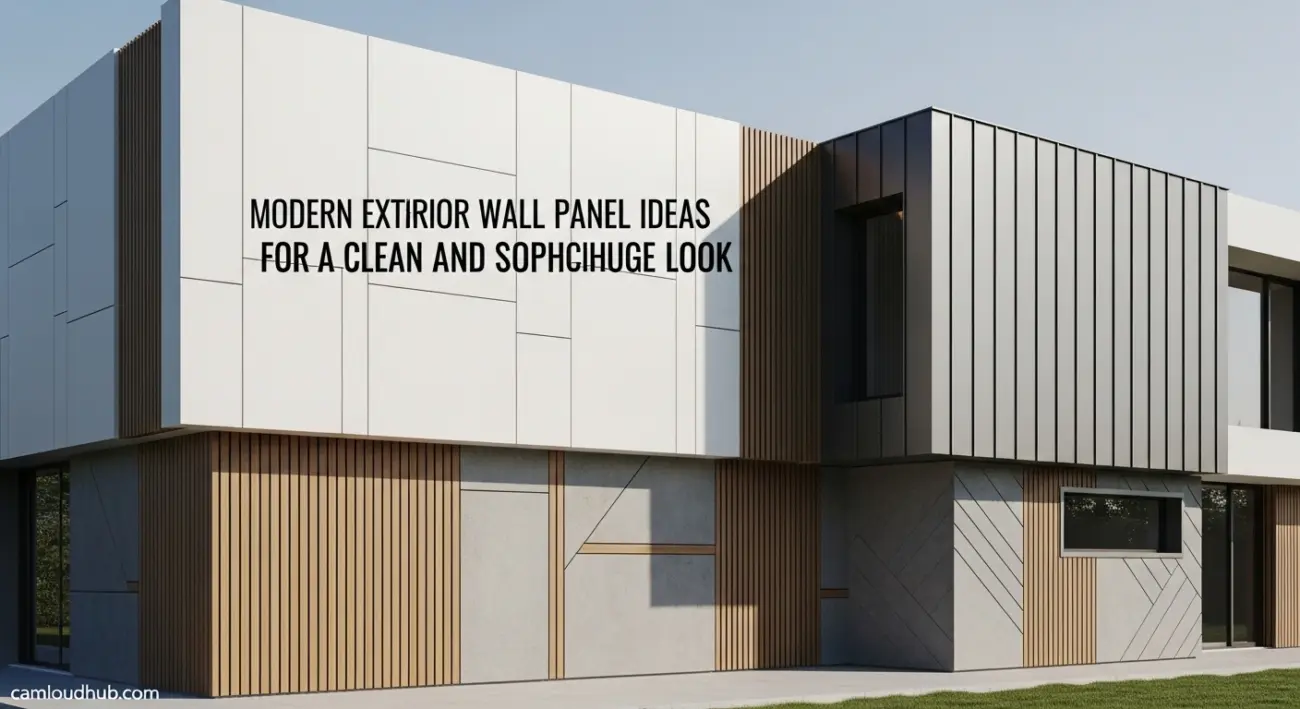Exploring the Appeal of Modern Exterior Wall Panels
Modern Exterior Wall Panel Ideas for a Clean and Sophisticated Look – Modern exterior wall panels have revolutionized the way we design and construct buildings. Their clean lines, customizable options, and ease of installation make them a preferred choice for architects and homeowners alike. Beyond aesthetics, these panels offer significant advantages in terms of energy efficiency, weather resistance, and ease of maintenance. The selection process requires careful consideration of factors like climate, architectural style, and budget to ensure a harmonious and lasting outcome. Let’s explore why the shift towards modern exterior wall panels is happening.
- Aesthetic Versatility: Modern panels come in a plethora of textures, colors, and finishes, allowing for endless design possibilities.
- Enhanced Durability: Many modern panel materials are engineered to withstand harsh weather conditions, resisting fading, cracking, and warping.
- Improved Insulation: Some panels offer excellent insulation properties, reducing energy consumption and lowering utility bills.

Key Materials for Modern Exterior Wall Panels
The choice of material is pivotal in defining the look and performance of your exterior wall panels. Each material offers unique characteristics that contribute to the overall aesthetic appeal and functional capabilities of the building. Understanding these differences will assist in selecting the ideal panel for your particular project.
Metal Panels: Sleek and Contemporary
Metal panels are a popular choice for modern exteriors due to their sleek aesthetics and longevity. Aluminum is a popular choice because it is light-weight, resistant to corrosion, and is easy to maintain. Steel provides superior strength and durability, though susceptible to corrosion if left unprotected. Copper offers a timeless and elegant look, developing a unique patina over time.
- Aluminum: Lightweight, rust-proof, and recyclable making it quite popular. Offers design versatility and exceptional endurance. Often used in curtain wall systems.
- Steel: High strength and durability but requires proper coating to prevent rust. An affordable and durable siding option.
- Copper: Provides an elegant appeal that develops a unique color as it ages. Copper’s natural protective coating forms a patina as it reacts with exterior pollutants.
Wood Panels: Embracing Natural Warmth
Wood panels offer a natural and inviting warmth to modern exteriors. This provides a stunning contrast to the sleek lines of modern design. From sustainable cedar to engineered wood composites, the options are endless. The choice of wood material depends on aesthetics and structural constraints. Regular maintenance is necessary for wood panels to protect them from the elements.
- Cedar: Resistant to rot and insects, offering a classic wood aesthetic. It contains natural oils that are water resistant.
- Engineered Wood: Offers enhanced durability and resistance to pests, providing a sustainable alternative.
- Thermally Modified Wood: Heat treating makes this wood especially resistant to rot fungus, decreasing water absorption and increasing dimensional stability.
Stone Panels: Timeless Elegance
Stone panels provide buildings with timeless elegance by bringing natural texture and durability. Manufactured stone veneer provides a way to achieve the look of natural stone, while reducing the weight and installation costs. Choosing the right type of stone can bring depth to any design, from rustic to modern.
- Natural Stone: Offers undeniable durability, and unique textures, bringing a classical ambience to your building.
- Manufactured Stone Veneer: A cost-effective and lightweight alternative to natural stone, easily installed and diverse in style.
Composite Panels: Engineered for Performance
Composite panels combine various materials to improve aesthetic and practical qualities. These panels offer benefits such as improved durability, insulation, and design adaptability. These can be ideal for designs prioritizing performance along with contemporary aesthetics.
- Aluminum Composite Material (ACM): Lightweight, rigid, and available in various colors, enhancing design flexibility.
- Fiber Cement: Durable, fire-resistant, and mimics the appearance of wood or stone, ideal when blending aesthetics with fire-resistant design.
- Insulated Metal Panels (IMPs): Combines metal exterior with insulation to improve energy efficiency and decrease noise.
Design Considerations for Modern Exterior Wall Panels
Selecting the right design and color for modern exterior wall panels significantly impacts the overall aesthetic of your building. This involves considering factors like architectural style, color palettes, and panel textures to achieve a cohesive and sophisticated look. Let’s explore some critical design aspects.

Color Palettes: Achieving a Harmonious Look
Color plays a vital role in defining the aesthetic appeal of your exterior. Neutral colors such as grays, whites, and beiges provide a timeless and sophisticated look. Contrasting colors can highlight architectural details, making an impact. Using monochromatic colors offers a sleek and minimalistic aesthetic. Coordinate the wall panels with other building elements to ensure a unified appearance.
- Neutral Shades: Ideal for timeless sophistication, reflecting light and maintaining a clean, modern look.
- Contrasting Hues: Create visual interest highlighting architectural features and defining the building’s design.
- Monochromatic Schemes: Offer a modern and minimalist aesthetic, emphasizing clean lines and uniformity.
Textures and Patterns: Adding Depth and Interest
The texture and pattern of exterior wall panels enhance the visual depth and character of your building. Smooth panels offer a sleek and minimalist look, while textured panels offer depth and visual interest. Geometric, or linear patterns can bring a unique, contemporary twist to the building’s facade. The right choice creates visual depth and character, highlighting the building’s overall design.
- Smooth Finishes: Ideal for minimalist designs, offering a clean and flawless appearance.
- Textured Surfaces: Add depth and dimension, creating visual interest and tactile appeal.
- Geometric or Linear Patterns: Brings contemporary and unique design to a building.
Panel Orientation and Arrangement: Creating Visual Impact
The way panels are aligned and arranged impacts the aesthetics of the facade. Horizontal panel alignment provides an elongating effect, which is great for long, slender buildings. Vertical panel alignment can emphasize height. Patterns and layouts can be varied to create a visually striking facade. Careful planning will optimize your desired visual effect.
- Horizontal Alignment: Creates the effect of length, great for slender designs.
- Vertical Alignment: Highlights height, making the structure imposing.
- Patterned Arrangements: Provides a unique and dynamic visual that attracts the eye.
Installation Techniques and Best Practices
Proper installation is essential for the durability and performance of modern exterior wall panels. Following best practices ensures not only structural integrity but also enhances the aesthetic appearance of the panel. This involves surface preparation, correct fastening techniques, and professional installation.
Surface Preparation: Ensuring a Solid Foundation
Proper preparation of the substrate ensures the longevity of the panels. Ensuring that the surface is clean, dry, and smooth is essential. Addressing any structural issues before installation prevents future issues. Applying a moisture barrier protects against water damage ensuring lasting performance.
- Cleaning and Leveling: Removes dirt and ensures surface uniformity for stable panel attachment.
- Structural Repairs: Repairs any issues prior to installation.
- Moisture Barriers: Protects against water damage and ensures that it lasts over time.
Fastening Techniques: Secure and Reliable Attachment
Using the correct fastening methods ensures that the panels are safely secured. Mechanical fasteners can offer strong and secure attachment options that are appropriate for various panel materials. Hidden fastener systems achieve a clean appearance by concealing screws. Proper fastener spacing prevents issues and guarantees the structural integrity of the panel.
- Mechanical Fasteners: Ensures that it will be securely in place and is appropriate for a broad spectrum of panel materials.
- Hidden Fastener Systems: Creates a clean aesthetic that is invisible
- Correct Spacing: Keeps everything structurally sound
Professional Installation: Expertise and Precision
Professional installers bring valuable knowledge of working with complex panel systems. These experts handle site inspections, accurate measurements, and precise cutting in order to reduce waste. Warranties that cover both materials and labor can protect your investment. Working with professionals will give you a quality finish every time.
- Site Inspection: Assessing conditions can guarantee the right installation preparation.
- Precise Cutting: Minimizes material waste, and guarantees an ideal precise fit.
- Comprehensive Warranties: Safeguard your investment through both material and labor protection.
Maintenance and Care for Exterior Wall Panels
Proper maintenance ensures lasting appeal and performance for exterior wall panels. Regular cleaning keeps the panels attractive by eliminating grime. Periodic inspections help identify minor issues, which can then be addressed right away. Weatherproofing helps to maintain the panels over time.
Regular Cleaning: Maintaining Aesthetic Appeal
Cleaning your panels prevents grime and dirt buildup. Soft brushes, and mild detergents should be used to protect the finish of the panels. Avoiding harsh chemicals help keep your panels from being destroyed or faded. These routine steps ensures that your panels stay appealing.
- Gentle Washing Methods: To safeguard the finish, use soft brushes and mild detergents.
- Prevention of Harsh Chemicals: Prevents surface degradation and preserves the panel’s original appearance.
Inspections and Repairs: Addressing Issues Promptly
Regular inspections help identify any defects before they escalate into serious problems. Prompt minor repairs, such as small cracks, and loose fasteners stops more extensive damage. Working to fix these issues as they come up extends pane life.
- Early Issue Identification: Allows for prompt fixes and decreases future substantial repairs.
- Proper Repair Techniques: Preserves structural integrity and prevent moisture intrusion.
Weatherproofing: Protecting Against the Elements
Using weatherproofing solutions provides extra protection for the panel. Sealing gaps and joints prevents water intrusion and keeps your panels stable. Applying protective coatings keep your panels from fading from the sun. This proactive approach makes your panels more durable over the course of their lifespan.
- Sealing Gaps and Joints: Prevents water damage and ensures that the structure of the building is sound.
- Protective Coatings: Keeps your panels beautiful with UV barriers.
Cost Considerations for Modern Exterior Wall Panels
Understanding the costs associated with different modern exterior wall panel ideas is crucial for homeowners and architects. This includes the price of materials, installation costs, and long-term maintenance expenses. Balancing cost and value ensures an affordable and sustainable solution.
Material Costs: Comparing Options
The overall cost is influenced by material choice. Aluminum, and composite pane tend to be cost-effective up front, while stone and exotic wood have a higher initial cost. It is important to consider the total cost of material, including installation, and how they are valued over time. Knowing these costs will give you better budget planning, and help you choose appropriately for the project that you are undertaking.
- Initial Material Price: Varies widely between material types, influencing selections
- Durability vs. Cost: Balancing upfront expenditures with long-term durability provides value and long-term maintenance costs.
Installation Costs: Labor and Complexity
Installation can be expensive, and depends on the panel material and the design of the building. Intricate designs and hard to reach areas all incur higher labor costs. Getting multiple quotes assures that you are using competitive pricing, and maximizes your investment.
- Complexity: Intricate projects with unique designs drive up labor costs.
- Competitive Bids: Comparing quotes from different contractors finds the most competitive pricing.
Long-Term Maintenance: Budgeting for the Future
Maintenance costs vary between materials. Long-lasting materials that are low maintenance, reduce long-term cost. Factoring maintenance costs in the budget helps in making a sound investment option.
- Material Impact: Materials that have low maintenance needs, lower the long term cost.
- Maintenance Plans: Allocating a budget that is ongoing helps in long term maintenance planning.
Case Studies: Inspiring Modern Exterior Wall Panel Designs
Examining real-world examples of innovative modern exterior wall panel ideas can inspire new design approaches. These case studies showcase the versatility and aesthetic potential of different panel materials and installation techniques.
Residential Projects: Enhancing Curb Appeal
Modern homes benefit from panel installations that add visual interest combined with durability. By incorporating wood panels on single family builds, it provides a fresh aesthetic without impacting the environment. Metal panels applied to condos create an urban aesthetic.
- Blending Materials: Combining different panel types brings a cohesive design to residential spaces
- Accent Features: Panels add pops of color and texture that boost the eye appeal.
Commercial Projects: Creating a Professional Image
Businesses can utilize metal or composite panels in order to create a sleek, modern aesthetic on commercial buildings. These types of panels enhance look, are weather proof, and improve efficiency. Incorporating branding elements into the design of the panel strengthens the corporate identity.
- Slick Integration: Panel selection matches business branding improves perception and look.
- Efficiency: Lowers energy use
Public Buildings: Balancing Aesthetics and Functionality
Public spaces require panel material that lasts and are affordable. Fiber cement panels are good for schools, and office buildings as they are fire-resistant. Utilizing panels in public spaces are both lasting, affordable, and eye-catching to make public buildings.
- Eco Conscious Materials: Panels that are environment friendly promote sustainable public design.
- Durability and Safety: Panels enhance longevity
Integrating Sustainable Practices with Exterior Wall Panels
Sustainability is an important aspect of modern design; so when choosing panel materials, it is important to pick materials that help the earth stay green. The choice of eco-friendly materials helps reduce our ecological footprint. Implementation of energy-saving design reduces costs, and consumption of resources. Careful management of projects ensures sustainable construction.
Eco-Friendly Materials: Reducing Environmental Impact
Materials such as reclaimed wood, recycled stone, and recycled metal, lowers energy consumption. Purchasing panels from organizations that practice sustainable sourcing minimizes disruption of our natural ecosystem. Choosing eco-conscious material helps with reducing building impact.
- Recycled Content: Materials that can be recovered offer reduction in waste.
- Sourcing Responsibility: Buying neighborhood, diminishes ecological impact,
Energy-Efficient Design: Lowering Energy Consumption
Selecting panels that insulate significantly reduces consumption and lowers utilities bill. Implementing building designs that have passive heating and cooling, helps with better sustainability. Building with energy efficient designs makes greener spaces.
- Insulation Properties: Paneled walls decreases usage, and energy.
- Passive Systems: Systems that use natural air flow, lower use of heating and air.
Sustainable Construction Practices: Responsible Building
Handling waste responsibly, helps with lowering footprint, and recycling products. Utilizing proper management, lowers carbon production, and ensures that sustainable construction projects are carried out. Sustainable construction helps to make future ecological designs sustainable.
- Waste Reduction: Responsible disposal lowers impact and costs.
- Carbon Footprint Minimization: Implementation of eco practices, provides sustainable builds.
The Future of Modern Exterior Wall Panels
Modern exterior wall panel ideas are always changing as innovations continue in materials and building technology. Expect to see more use of smart technology in combination with panel systems. Sustainable practices that lower impact is growing. Future developments will make buildings, energy efficient, affordable, and more attractive.
Technological Advancements: Smart and Interactive Panels
Panels with built-in sensors that monitor performance will change how constructions are designed. Panels that generate energy from solar and wind technology can greatly increase sustainability. Integration of smart and interactive tech improves building performance.

Emerging Materials: Innovations in Panel Construction
Self repairing and cleaning materials has the potential to increase panel life. Materials that change color based on weather, provides an impressive look. Advanced materials improve efficiency and longevity.
Evolving Design Trends: Pushing Aesthetic Boundaries
3D generated panel provides unique designs for modern exteriors. Personalized panels will allow builders to cater to individual tastes. Design trends will allow design that goes above the norm.
Conclusion
Exploring modern exterior wall panel ideas is essential for creating clean, sophisticated, and sustainable building exteriors. By carefully considering material options, design elements, installation techniques, and maintenance practices, homeowners and architects can achieve stunning results that enhance both the aesthetic appeal and functional performance of their buildings. From the sleek lines of metal panels to the warmth of natural stone, the possibilities are endless. Keep up with future developments that include technology, materials and construction.


